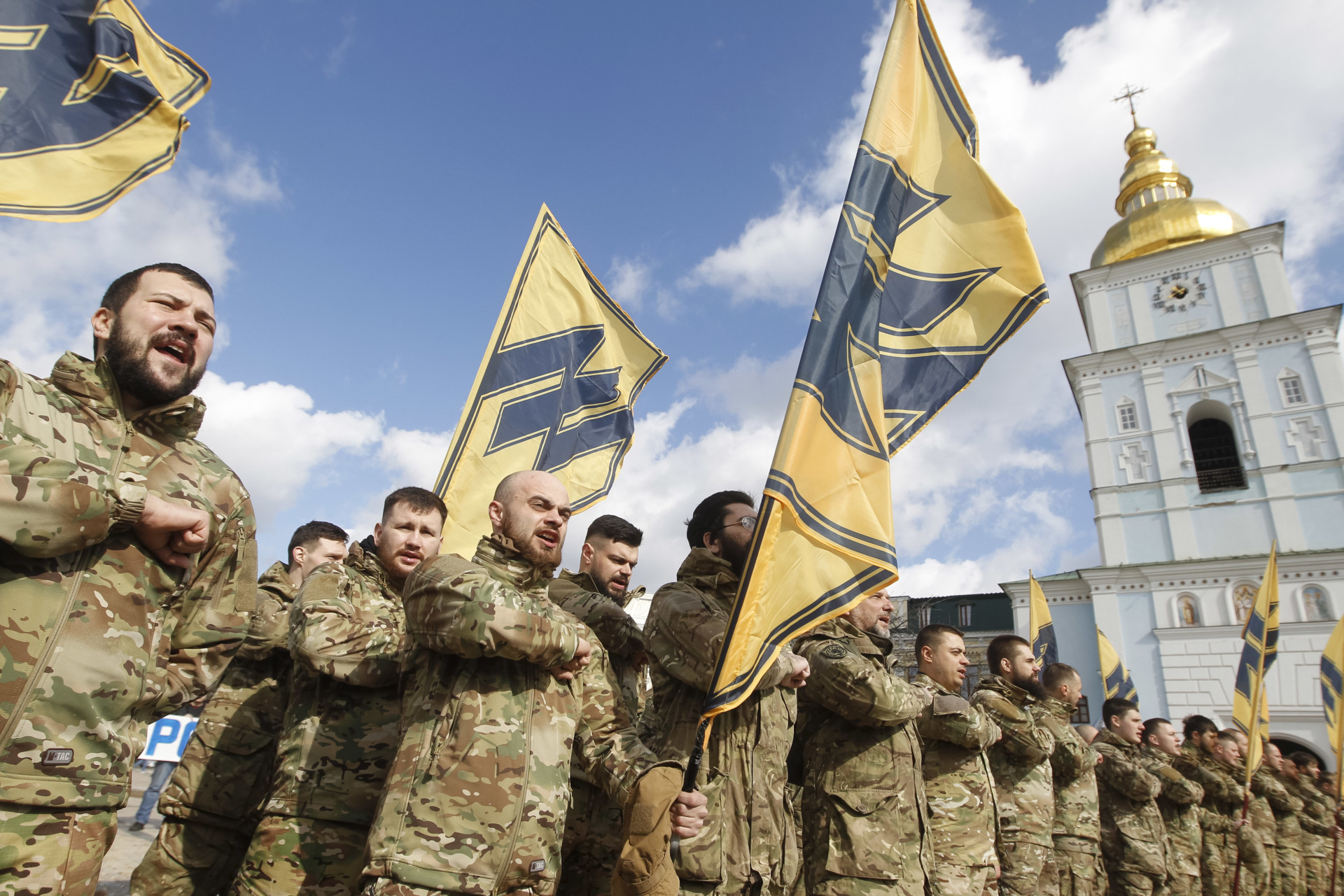Foreign fighters involved in the Ukrainian conflict who have far-right connections pose a credible regional and international security concern. They can be found on both sides of the conflict and are driven by similar ideologies. Without proper intervention, these foreign fighters returning home from Ukraine could bolster the already growing far-right movements worldwide. Russia is already using some of these far-right groups. With the EU weakened, a U.S. initiative to combat and deradicalize these far-right groups is needed.
Far-Right Fighters on Both Sides in Ukraine
On March 10, the State Court of Bosnia and Herzegovina acquitted Bosnian Serb Gavrilo Stevic of joining a pro-Russian separatist unit fighting in Ukraine. The Criminal Code of Bosnia and Herzegovina was expanded in 2014 to cover those who join “in any way a foreign paramilitary and parapolice formation.” So far, Bosnian authorities convicted at least two dozen returning fighters for participating in the Syrian conflict. Stevic’s was the first trial involving a Balkan fighter participating in the Ukrainian war.
Many reports and analyses have been produced in the last couple of years on the phenomenon of foreign fighters and the implications of returnees and their families. However, most of the research and policy work was focused on foreign fighters in Syria, while little attention has been paid to the implications of foreign fighters returning from Ukraine.
After the conflict started in Ukraine in 2013, a large number of volunteers from Europe flocked to join both sides. Mainly Orthodox Christian volunteers sided with the pro-Russian separatists, while Catholics and anti-Russians sided with the Ukrainian forces. The common denominator on both sides is the significant presence of far-right extremists. For example, embedded with the separatists was the Jovan Sevic Unit composed entirely of Serbs from Serbia and Bosnia and Herzegovina. Most of these fighters are connected with the Chetnik movement, the ultra-far-right Serbian movement formed during World War II.
These volunteers and others from predominantly Orthodox Christian countries – Russia, Belarus, and Serbia, for instance – view the conflict in Ukraine as a battle for Orthodox Christendom and a fight against Western European/NATO dominance. On the other hand, the Ukrainian forces were joined by a large number of neo-Nazis and white supremacists mainly from Western Europe. The most infamous unit with the Ukrainians is the Azov Brigade, known for publicly displaying neo-Nazi symbolism.
Interestingly, neo-Nazis could be found on both sides of the front. One 2016 report documented pro-Russian separatist units with neo-Nazi ideologies and links but also claimed that “the importance of far right groups on both sides has declined over time.”
A recent study on foreign fighters in Ukraine show that some “seem to have gone into the conflict with the specific purpose of gaining the necessary skills to conduct the acts of violence” and that most returnees “have kept in touch in some way or another with the people they’ve met on the front lines.” This study also put the foreign fighters into four categories: “experienced veterans coming to resettle old scores with either Ukraine or Russia,” “civilian highly ideologically engaged men,” unfulfilled activists “who felt they have exhausted the means of political activism (through art, literature, and NGO work) in their home countries,” and adventurous “battle chasers.” The study concludes that “the disillusioned ideologues and battle chasers of the adventurous civilian type are of the greatest concern.”
The Ukrainian war has shown another concerning fact: Former foreign fighters who took part in the Yugoslav wars during the 1990s re-emerged as recruiters and ideologues in Ukraine. A Frenchman who fought for Croatian forces in Croatia and Bosnia and Herzegovina led the recruitment for the Azov Brigade. A former Russian volunteer in the Serb forces who fought in Eastern Bosnia led recruitment for pro-Russian separatists.
The Broader Danger
In addition, some veterans and networks created in the Ukrainian war are strengthening far-right extremist groups throughout Europe. Unlike returnees from Syria, the veterans returning home from Ukraine do not undergo deradicalization and resocialization programs in their home states. On the contrary, there are examples of the veterans being used to spread influence and ideologies. For example, Russia is using some of these networks in order to spread their influence in the Balkans. In this specific case, a connection between the veterans of the Bosnian and Ukrainian wars and Bosnian Serb and Russian far-right political parties and social groups underscored a common anti-NATO motivation.
Some individuals radicalized in Ukraine planned to conduct terrorist attacks in Western Europe. In 2016, a Frenchman was arrested at the Polish-Ukrainian border with explosives and weapons. He had planned to carry out attacks on bridges, motorways, a mosque, and a synagogue during the UEFA European Championship football tournament.
Similarly, as seen in the case of the Golden Dawn in Greece, some of these veterans often tend to get politically involved. The National Corps, the political wing of the Azov Battalion, started to enjoy growing support throughout Ukraine. The group has been a feature of the Paneuropa conference, a gathering of far-right movements and political parties from around the world held annually in Kiev since 2017. The National Corps also found allies in Croatia, where they forged an alliance with far-right parties. This model of the Eastern European far-right is slowly being exported throughout Western Europe and to North America.
Responding to the Far Right
Policies toward foreign fighters and their recruiters differ from country to country. Initially ignoring the phenomenon, some countries slowly changed positions. Italy, for example, made arrests for recruitment and participation in 2018. Croatia, on the other hand, called on their citizens to return from Ukraine in 2015, after pressure from Russia, but did not prosecute them. Serbia held legal proceedings against 45 of their citizens but these usually ended with very small and lenient measures, in contrast with verdicts against foreign fighters returning from Syria.
The Ukrainian conflict gave veterans and ideologies from previous wars the opportunity to reappear in Europe. These re-emerging far-right ideologies have strengthened and spread not only across Europe but also in the United States. Several reports have found that far-right extremist groups have been on the rise in the United States during the last few years. In addition, a 2019 report shows that since the start of the Ukrainian conflict, far-right movements in Ukraine attempted to connect with far-right individuals and organizations in the United States.
Thus, the issue of foreign fighters and far-right movements calls for a more decisive approach by the United States. First, the rise of the far right will affect security in Europe, especially for vulnerable U.S. allies in Eastern Europe. Radicalized veterans within extremist groups could pose a national and regional security threat in NATO member states. Second, Russia is using these foreign fighters to undermine the European Union and NATO. Unlike other countries, Russia has an active role in getting fighters into the conflict, since the Russians’ goal is geopolitical instability of the region.
The United States needs to take the lead in tackling the global far-right phenomenon. Together with transatlantic allies, the United States can spearhead an initiative to have far-right extremist groups specially monitored and foreign fighter returnees prosecuted and deradicalized. Additionally, strengthening local partners through strategic capacity building for Ukrainian and Balkan state institutions is a necessity for preventing the growth of far-right extremism.
With the European Union’s position weakened by Brexit and additionally overwhelmed by the COVID-19 pandemic, populist far-right movements have stepped up their pace. Autocratic leaders are grabbing power while far-right groups are using disinformation to push their agenda. This could be an opportunity for the United States to launch an initiative and once again become a stabilizing factor in the region.
Dr. Hikmet Karcic is a Senior Fellow with the Newlines Institute and a scholar of genocide studies at the Institute for Islamic Tradition of Bosniaks in Sarajevo, Bosnia-Herzegovina.
The views expressed in this article are those of the author and not an official policy or position of the Newlines Institute.






